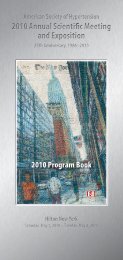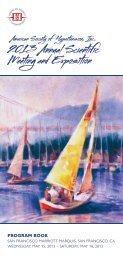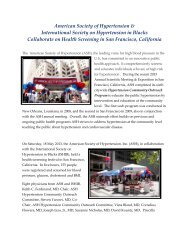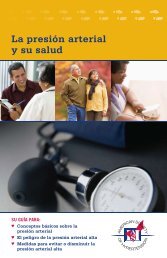2011 ASH Program Book - American Society of Hypertension
2011 ASH Program Book - American Society of Hypertension
2011 ASH Program Book - American Society of Hypertension
Create successful ePaper yourself
Turn your PDF publications into a flip-book with our unique Google optimized e-Paper software.
Animal Data<br />
No reproductive toxicity studies have been conducted with the combination <strong>of</strong><br />
aliskiren and amlodipine besylate. However, these studies have been conducted<br />
for aliskiren and amlodipine besylate alone.<br />
Aliskiren<br />
In developmental toxicity studies, pregnant rats and rabbits received oral<br />
aliskiren hemifumarate during organogenesis at doses up to 20 and 7 times<br />
the maximum recommended human dose (MRHD) based on body surface<br />
area (mg/m 2 ), respectively, in rats and rabbits. (Actual animal doses were up<br />
to 600 mg/kg/day in rats and up to 100 mg/kg/day in rabbits.) No teratogenicity<br />
was observed; however, fetal birth weight was decreased in rabbits at<br />
doses 3.2 times the MRHD based on body surface area (mg/m 2 ). Aliskiren<br />
was present in placentas, amniotic fluid and fetuses <strong>of</strong> pregnant rabbits.<br />
Amlodipine<br />
In developmental toxicity studies, pregnant rats and rabbits received oral<br />
amlodipine maleate during organogenesis at doses approximately 10 and 20<br />
times the maximum recommended human dose (MRHD) based on body surface<br />
area (mg/m 2 ), respectively, in rats and rabbits. (Actual animal doses<br />
were up to 10 mg/kg/day.) No evidence <strong>of</strong> teratogenicity or other embryo fetal<br />
toxicity was observed. However, litter size was decreased approximately 50%<br />
and the num ber <strong>of</strong> intrauterine deaths was increased approximately 5-fold for<br />
rats receiving amlodipine maleate at doses approximately 10 times the MRHD<br />
based on body surface area (mg/m 2 ) for 14 days before mating and throughout<br />
mating and gestation. Amlodipine maleate has been shown to prolong<br />
both the gestation period and the duration <strong>of</strong> labor in rats at this dose.<br />
8.3 Nursing Mothers<br />
It is not known whether aliskiren or amlodipine is excreted in human milk.<br />
Both aliskiren and amlodipine are secreted in the milk <strong>of</strong> lactating rats.<br />
Because <strong>of</strong> the potential for serious adverse reactions in human milk-fed<br />
infants from Tekamlo, a decision should be made whether to discontinue<br />
nursing or discontinue Tekamlo, taking into account the importance <strong>of</strong> the<br />
drug to the mother.<br />
8.4 Pediatric Use<br />
Safety and effectiveness <strong>of</strong> Tekamlo in pediatric patients have not been<br />
established.<br />
8.5 Geriatric Use<br />
Tekamlo<br />
In the short-term controlled clinical trials <strong>of</strong> Tekamlo, 17% <strong>of</strong> patients treated<br />
with Tekamlo were ≥65 years. No overall differences in safety or effectiveness<br />
were observed between these subjects and younger subjects. Other reported<br />
clinical experience has not identified differences in responses between the<br />
elderly and younger patients, but greater sensitivity <strong>of</strong> some older individuals<br />
cannot be ruled out.<br />
Aliskiren<br />
Impact <strong>of</strong> aging on aliskiren pharmacokinetics has been assessed, when<br />
compared to young adults (18-40 years), aliskiren mean AUC and C max in<br />
elderly subjects (>65 years) are increased by 57% and 28%, respectively.<br />
However, differences in efficacy and safety between the elderly and younger<br />
populations were minor, indicating that differences in exposure due to age do<br />
not significantly alter the clinical effect <strong>of</strong> the drug. Therefore, no starting<br />
dose adjustment in geriatric population is required.<br />
Amlodipine<br />
Other reported clinical experience has not identified differences in responses<br />
between the elderly and younger patients. However, elderly patients have<br />
decreased clearance <strong>of</strong> amlodipine with a resulting increase <strong>of</strong> AUC <strong>of</strong> approx -<br />
imately 40-60%. In general dose selection for an elderly patient should be<br />
cautious, usually starting at the low end <strong>of</strong> the dosing range, reflecting the<br />
greater frequency <strong>of</strong> decreased hepatic, renal or cardiac function, and <strong>of</strong> concomitant<br />
disease or other drug therapy.<br />
10 OVERDOSAGE<br />
Aliskiren<br />
Limited data are available related to overdosage in humans. The most likely<br />
manifestation <strong>of</strong> overdosage would be hypotension. If symptomatic hypotension<br />
should occur, provide supportive treatment.









